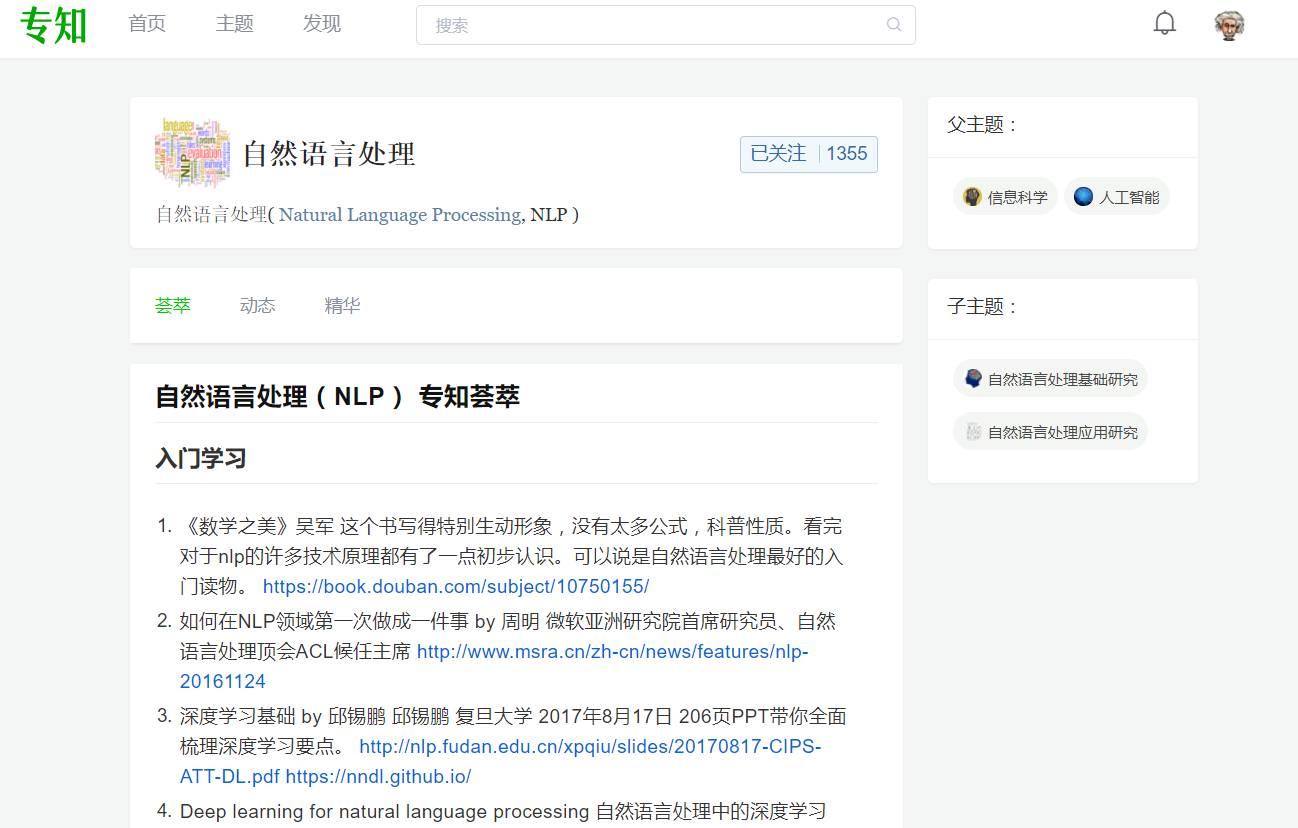【专知荟萃02】自然语言处理NLP知识资料大全集(入门/进阶/论文/Toolkit/数据/综述/专家等)(附pdf下载)
点击上方“专知”关注获取更多AI知识!
【导读】主题荟萃知识是专知的核心功能之一,为用户提供AI领域系统性的知识学习服务。主题荟萃为用户提供全网关于该主题的精华(Awesome)知识资料收录整理,使得AI从业者便捷学习和解决工作问题!在专知人工智能主题知识树基础上,主题荟萃由专业人工编辑和算法工具辅助协作完成,并保持动态更新!另外欢迎对此创作主题荟萃感兴趣的同学,请加入我们专知AI创作者计划,共创共赢! 今天专知为大家呈送第二篇专知主题荟萃-自然语言处理知识资料全集荟萃 (入门/进阶/论文/toolkit/数据/专家等),请大家查看!专知访问www.zhuanzhi.ai, 或关注微信公众号后台回复" 专知"进入专知,搜索主题“深度学习”查看。欢迎转发分享!此外,我们也提供该文pdf下载链接,请文章末尾查看!
了解专知,专知,一个新的认知方式!
自然语言处理(NLP) 专知荟萃
入门学习
进阶论文
Word Vectors
Machine Translation
Summarization
Text Classification
Dialogs
Reading Comprehension
Memory and Attention Models
reinforcement learning in nlp
GAN for NLP
综述
视频课程
Tutorial
图书
领域专家
国内
国际
会议
自然语言处理国际会议
相关包含NLP内容的其他会议
期刊
国内会议 通常都包含丰富的讲习班和Tutorial 公开的PPT都是很好的学习资源
Toolkit Library
Python Libraries
C++ Libraries
Java Libraries
中文
datasets
自然语言处理(NLP) 专知荟萃
入门学习
《数学之美》吴军 这个书写得特别生动形象,没有太多公式,科普性质。看完对于nlp的许多技术原理都有了一点初步认识。可以说是自然语言处理最好的入门读物。
https://book.douban.com/subject/10750155/
如何在NLP领域第一次做成一件事 by 周明 微软亚洲研究院首席研究员、自然语言处理顶会ACL候任主席
http://www.msra.cn/zh-cn/news/features/nlp-20161124
深度学习基础 by 邱锡鹏 邱锡鹏 复旦大学 2017年8月17日 206页PPT带你全面梳理深度学习要点。
http://nlp.fudan.edu.cn/xpqiu/slides/20170817-CIPS-ATT-DL.pdf
https://nndl.github.io/
Deep learning for natural language processing 自然语言处理中的深度学习 by 邱锡鹏 主要讨论了深度学习在自然语言处理中的应用。其中涉及的模型主要有卷积神经网络,递归神经网络,循环神经网络网络等,应用领域主要包括了文本生成,问答系统,机器翻译以及文本匹配等。http://nlp.fudan.edu.cn/xpqiu/slides/20160618_DL4NLP@CityU.pdf
Deep Learning, NLP, and Representations (深度学习,自然语言处理及其表达) 来自著名的colah's blog,简要概述了DL应用于NLP的研究,重点介绍了Word Embeddings。
http://colah.github.io/posts/2014-07-NLP-RNNs-Representations/ 翻译: http://blog.csdn.net/ycheng_sjtu/article/details/48520293
《中文信息发展报告》 by 中国中文信息学会 2016年12月 是一份非常好的中文NLP总览性质的文档,通过这份报告可以了解中文和英文NLP主要的技术方向。
http://cips-upload.bj.bcebos.com/cips2016.pdf
Deep Learning in NLP (一)词向量和语言模型 by Lai Siwei(来斯惟) 中科院自动化所 2013 比较详细的介绍了DL在NLP领域的研究成果,系统地梳理了各种神经网络语言模型
http://licstar.net/archives/328
语义分析的一些方法(一,二,三) by 火光摇曳 腾讯广点通
http://www.flickering.cn/ads/2015/02/
我们是这样理解语言的-3 神经网络语言模型 by 火光摇曳 腾讯广点通 总结了词向量和常见的几种神经网络语言模型
http://www.flickering.cn/nlp/2015/03/
深度学习word2vec笔记之基础篇 by falao_beiliu http://blog.csdn.net/mytestmy/article/details/26961315
Understanding Convolutional Neural Networks for NLP 卷积神经网络在自然语言处理的应用 by WILDMLhttp://www.wildml.com/2015/11/understanding-convolutional-neural-networks-for-nlp 翻译:http://www.csdn.net/article/2015-11-11/2826192
The Unreasonable Effectiveness of Recurrent Neural Networks. 循环神经网络惊人的有效性 by Andrej
Karpathyhttp://karpathy.github.io/2015/05/21/rnn-effectiveness/ 翻译: https://zhuanlan.zhihu.com/p/22107715
Understanding LSTM Networks 理解长短期记忆网络(LSTM NetWorks) by colahhttp://colah.github.io/posts/2015-08-Understanding-LSTMs/ 翻译:http://www.csdn.net/article/2015-11-25/2826323?ref=myread
注意力机制(Attention Mechanism)在自然语言处理中的应用 by robert_ai _ http://www.cnblogs.com/robert-dlut/p/5952032.html
初学者如何查阅自然语言处理(NLP)领域学术资料 刘知远http://blog.sina.com.cn/s/blog_574a437f01019poo.html
进阶论文
Word Vectors
Word2vec Efficient Estimation of Word Representations in Vector Space http://arxiv.org/pdf/1301.3781v3.pdf
Doc2vec Distributed Representations of Words and Phrases and their Compositionalityhttp://papers.nips.cc/paper/5021-distributed-representations-of-words-and-phrases-and-their-compositionality.pdf
Word2Vec tutorialhttp://tensorflow.org/tutorials/word2vec/index.html in TensorFlowhttp://tensorflow.org/
GloVe : Global vectors for word representation http://nlp.stanford.edu/projects/glove/glove.pdf
How to Generate a Good Word Embedding? 怎样生成一个好的词向量? Siwei Lai, Kang Liu, Liheng Xu, Jun Zhao https://arxiv.org/abs/1507.05523 code: https://github.com/licstar/compare note:http://licstar.net/archives/620
tweet2vec http://arxiv.org/abs/1605.03481
tweet2vec https://arxiv.org/abs/1607.07514
author2vec http://dl.acm.org/citation.cfm?id=2889382
item2vec http://arxiv.org/abs/1603.04259
lda2vec https://arxiv.org/abs/1605.02019
illustration2vec http://dl.acm.org/citation.cfm?id=2820907
tag2vechttp://ktsaurabh.weebly.com/uploads/3/1/7/8/31783965/distributed_representations_for_contentbased_and_personalized_tag_recommendation.pdf
category2vec http://www.anlp.jp/proceedings/annual_meeting/2015/pdfdir/C43.pdf]
topic2vec http://arxiv.org/abs/1506.08422
image2vec http://arxiv.org/abs/1507.08818
app2vec http://paul.rutgers.edu/qma/research/maapp2vec.pdf
prod2vec http://dl.acm.org/citation.cfm?id=2788627
metaprod2vec http://arxiv.org/abs/1607.07326
sense2vec http://arxiv.org/abs/1511.06388
node2vec http://www.kdd.org/kdd2016/papers/files/Paper_218.pdf
subgraph2vec http://arxiv.org/abs/1606.08928
wordnet2vec http://arxiv.org/abs/1606.03335
doc2sent2vec http://research.microsoft.com/apps/pubs/default.aspx?id=264430
context2vec http://u.cs.biu.ac.il/melamuo/publications/context2vecconll16.pdf
rdf2vec http://iswc2016.semanticweb.org/pages/program/acceptedpapers.html#research_ristoski_32
hash2vec http://arxiv.org/abs/1608.08940
query2vec http://www.cs.cmu.edu/dongyeok/papers/query2vecv0.2.pdf
gov2vec http://arxiv.org/abs/1609.06616
novel2vec http://aics2016.ucd.ie/papers/full/AICS_2016_paper_48.pdf
emoji2vec http://arxiv.org/abs/1609.08359
video2vec https://staff.fnwi.uva.nl/t.e.j.mensink/publications/habibian16pami.pdf
video2vec http://www.public.asu.edu/bli24/Papers/ICPR2016video2vec.pdf
sen2vec https://arxiv.org/abs/1610.08078
content2vec http://104.155.136.4:3000/forum?id=ryTYxh5ll
cat2vec http://104.155.136.4:3000/forum?id=HyNxRZ9xg
diet2vec https://arxiv.org/abs/1612.00388
mention2vec https://arxiv.org/abs/1612.02706
POI2vec http://www.ntu.edu.sg/home/boan/papers/AAAI17_Visitor.pdf
wang2vec http://www.cs.cmu.edu/lingwang/papers/naacl2015.pdf
dna2vec https://arxiv.org/abs/1701.06279
pin2vec https://labs.pinterest.com/assets/paper/p2pwww17.pdf, (cited blog(https://medium.com/thegraph/applyingdeeplearningtorelatedpinsa6fee3c92f5e#.erb1i5mze))
paper2vec https://arxiv.org/abs/1703.06587
struc2vec https://arxiv.org/abs/1704.03165
med2vec http://www.kdd.org/kdd2016/papers/files/rpp0303choiA.pdf
net2vec https://arxiv.org/abs/1705.03881
sub2vec https://arxiv.org/abs/1702.06921
metapath2vec https://ericdongyx.github.io/papers/KDD17dongchawlaswamimetapath2vec.pdf
concept2vechttp://knoesis.cs.wright.edu/sites/default/files/Concept2vec__Evaluating_Quality_of_Embeddings_for_OntologicalConcepts%20%284%29.pdf
graph2vec http://arxiv.org/abs/1707.05005
doctag2vec https://arxiv.org/abs/1707.04596
skill2vec https://arxiv.org/abs/1707.09751
style2vec https://arxiv.org/abs/1708.04014
ngram2vec http://www.aclweb.org/anthology/D171023
Machine Translation
Neural Machine Translation by jointly learning to align and translate http://arxiv.org/pdf/1409.0473v6.pdf
Sequence to Sequence Learning with Neural Networks http://arxiv.org/pdf/1409.3215v3.pdf PPT: [nips presentationhttp://research.microsoft.com/apps/video/?id=239083 seq2seq tutorialhttp://tensorflow.org/tutorials/seq2seq/index.html
Cross-lingual Pseudo-Projected Expectation Regularization for Weakly Supervised Learninghttp://arxiv.org/pdf/1310.1597v1.pdf
Generating Chinese Named Entity Data from a Parallel Corpus http://www.mt-archive.info/IJCNLP-2011-Fu.pdf
IXA pipeline: Efficient and Ready to Use Multilingual NLP tools http://www.lrec-conf.org/proceedings/lrec2014/pdf/775_Paper.pdf
Summarization
Extraction of Salient Sentences from Labelled Documents arxiv: http://arxiv.org/abs/1412.6815 github: https://github.com/mdenil/txtnets
A Neural Attention Model for Abstractive Sentence Summarization. EMNLP 2015. Facebook AI Research arxiv: http://arxiv.org/abs/1509.00685 github: https://github.com/facebook/NAMAS github(TensorFlow): https://github.com/carpedm20/neuralsummarytensorflow
A Convolutional Attention Network for Extreme Summarization of Source Code homepage: http://groups.inf.ed.ac.uk/cup/codeattention/ arxiv: http://arxiv.org/abs/1602.03001 github: https://github.com/jxieeducation/DIYDataScience/blob/master/papernotes/2016/02/convattentionnetworksourcecodesummarization.md
Abstractive Text Summarization Using SequencetoSequence RNNs and Beyond. BM Watson & Université de Montréal arxiv: http://arxiv.org/abs/1602.06023
textsum: Text summarization with TensorFlow blog: https://research.googleblog.com/2016/08/textsummarizationwithtensorflow.html github: https://github.com/tensorflow/models/tree/master/textsum
How to Run Text Summarization with TensorFlow blog: https://medium.com/@surmenok/howtoruntextsummarizationwithtensorflowd4472587602d#.mll1rqgjg github: https://github.com/surmenok/TextSum
Text Classification
Convolutional Neural Networks for Sentence Classification arxiv: http://arxiv.org/abs/1408.5882 github: https://github.com/yoonkim/CNN_sentence github: https://github.com/harvardnlp/sentconvtorch github: https://github.com/alexanderrakhlin/CNNforSentenceClassificationinKeras github: https://github.com/abhaikollara/CNNSentenceClassification
Recurrent Convolutional Neural Networks for Text Classification paper: http://www.aaai.org/ocs/index.php/AAAI/AAAI15/paper/view/9745/9552 github: https://github.com/knok/rcnntextclassification
Characterlevel Convolutional Networks for Text Classification.NIPS 2015. "Text Understanding from Scratch" arxiv: http://arxiv.org/abs/1509.01626 github: https://github.com/zhangxiangxiao/Crepe datasets: http://goo.gl/JyCnZq github: https://github.com/mhjabreel/CharCNN
A CLSTM Neural Network for Text Classification arxiv: http://arxiv.org/abs/1511.08630 RationaleAugmented Convolutional Neural Networks for Text Classification arxiv: http://arxiv.org/abs/1605.04469
Text classification using DIGITS and Torch7 github: https://github.com/NVIDIA/DIGITS/tree/master/examples/textclassification
Recurrent Neural Network for Text Classification with MultiTask Learning arxiv: http://arxiv.org/abs/1605.05101
Deep MultiTask Learning with Shared Memory. EMNLP 2016 arxiv: https://arxiv.org/abs/1609.07222
Virtual Adversarial Training for SemiSupervised Text arxiv: http://arxiv.org/abs/1605.07725notes: https://github.com/dennybritz/deeplearning-papernotes/blob/master/notes/adversarial-text-classification.md
Bag of Tricks for Efficient Text Classification. Facebook AI Research arxiv: http://arxiv.org/abs/1607.01759github: https://github.com/kemaswill/fasttext_torch github: https://github.com/facebookresearch/fastText
Actionable and Political Text Classification using Word Embeddings and LSTM arxiv: http://arxiv.org/abs/1607.02501 Implementing a CNN for Text Classification in TensorFlow blog: http://www.wildml.com/2015/12/implementingacnnfortextclassificationintensorflow/
fancycnn: Multiparadigm Sequential Convolutional Neural Networks for text classification github: https://github.com/textclf/fancycnn
Convolutional Neural Networks for Text Categorization: Shallow Wordlevel vs. Deep Characterlevel arxiv: http://arxiv.org/abs/1609.00718 Tweet Classification using RNN and CNN github: https://github.com/ganeshjawahar/tweetclassify
Hierarchical Attention Networks for Document Classification. NAACL 2016 paper: https://www.cs.cmu.edu/diyiy/docs/naacl16.pdf github: https://github.com/raviqqe/tensorflowfont2char2word2sent2doc github: https://github.com/ematvey/deeptextclassifier
ACBLSTM: Asymmetric Convolutional Bidirectional LSTM Networks for Text Classification arxiv: https://arxiv.org/abs/1611.01884 github: https://github.com/Ldpe2G/ACBLSTM
Generative and Discriminative Text Classification with Recurrent Neural Networks. DeepMind arxiv: https://arxiv.org/abs/1703.01898
Adversarial Multitask Learning for Text Classification. ACL 2017 arxiv: https://arxiv.org/abs/1704.05742 data: http://nlp.fudan.edu.cn/data/
Deep Text Classification Can be Fooled. Renmin University of China arxiv: https://arxiv.org/abs/1704.08006
Deep neural network framework for multilabel text classification github: https://github.com/inspirehep/magpie
MultiTask Label Embedding for Text Classification arxiv: https://arxiv.org/abs/1710.07210
Dialogs
A Neural Network Approach toContext-Sensitive Generation of Conversational Responses. by Sordoni 2015. Generates responses to tweets. http://arxiv.org/pdf/1506.06714v1.pdf
Neural Responding Machine for Short-Text Conversation 使用微博数据单轮对话正确率达到75%http://arxiv.org/pdf/1503.02364v2.pdf
A Neural Conversation Model http://arxiv.org/pdf/1506.05869v3.pdf
Visual Dialog webiste: http://visualdialog.org/ arxiv: https://arxiv.org/abs/1611.08669github: https://github.com/batra-mlp-lab/visdial-amt-chat github(Torch): https://github.com/batra-mlp-lab/visdialgithub(PyTorch): https://github.com/Cloud-CV/visual-chatbot demo: http://visualchatbot.cloudcv.org/
Papers, code and data from FAIR for various memory-augmented nets with application to text understanding and dialogue. post: https://www.facebook.com/yann.lecun/posts/10154070851697143
Neural Emoji Recommendation in Dialogue Systems arxiv: https://arxiv.org/abs/1612.04609
Reading Comprehension
Text Understanding with the Attention Sum Reader Network. ACL 2016 arxiv: https://arxiv.org/abs/1603.01547github: https://github.com/rkadlec/asreader
A Thorough Examination of the CNN/Daily Mail Reading Comprehension Task arxiv: http://arxiv.org/abs/1606.02858 github: https://github.com/danqi/rccnndailymail
Consensus Attentionbased Neural Networks for Chinese Reading Comprehension arxiv: http://arxiv.org/abs/1607.02250 dataset: http://hfl.iflytek.com/chineserc/
Separating Answers from Queries for Neural Reading Comprehension arxiv: http://arxiv.org/abs/1607.03316github: https://github.com/dirkweissenborn/qa_network
AttentionoverAttention Neural Networks for Reading Comprehension arxiv: http://arxiv.org/abs/1607.04423github: https://github.com/OlavHN/attentionoverattention
Teaching Machines to Read and Comprehend CNN News and Children Books using Torch github: https://github.com/ganeshjawahar/torchteacher
Reasoning with Memory Augmented Neural Networks for Language Comprehension arxiv: https://arxiv.org/abs/1610.06454
Bidirectional Attention Flow: Bidirectional Attention Flow for Machine Comprehension project page: https://allenai.github.io/biattflow/ github: https://github.com/allenai/biattflow
NewsQA: A Machine Comprehension Dataset arxiv: https://arxiv.org/abs/1611.09830 dataset: http://datasets.maluuba.com/NewsQA github: https://github.com/Maluuba/newsqa
GatedAttention Readers for Text Comprehension arxiv: https://arxiv.org/abs/1606.01549 github: https://github.com/bdhingra/gareader
Get To The Point: Summarization with PointerGenerator Networks. ACL 2017. Stanford University & Google Brain arxiv: https://arxiv.org/abs/1704.04368 github: https://github.com/abisee/pointergenerator
Memory and Attention Models
Reasoning, Attention and Memory RAM workshop at NIPS 2015.http://www.thespermwhale.com/jaseweston/ram/
Memory Networks. Weston et. al 2014 http://arxiv.org/pdf/1410.3916v10.pdf
End-To-End Memory Networks http://arxiv.org/pdf/1503.08895v4.pdf
Towards AI-Complete Question Answering: A Set of Prerequisite Toy Taskshttp://arxiv.org/pdf/1502.05698v7.pdf
Evaluating prerequisite qualities for learning end to end dialog systemshttp://arxiv.org/pdf/1511.06931.pdf
Neural Turing Machines http://arxiv.org/pdf/1410.5401v2.pdf
Inferring Algorithmic Patterns with Stack-Augmented Recurrent Netshttp://arxiv.org/pdf/1503.01007v4.pdf
Reasoning about Neural Attention https://arxiv.org/pdf/1509.06664v1.pdf
A Neural Attention Model for Abstractive Sentence Summarization https://arxiv.org/pdf/1509.00685.pdf
Neural Machine Translation by Jointly Learning to Align and Translate https://arxiv.org/pdf/1409.0473v6.pdf
Recurrent Continuous Translation Models https://www.nal.ai/papers/KalchbrennerBlunsom_EMNLP13
Learning Phrase Representations using RNN Encoder-Decoder for Statistical Machine Translationhttps://arxiv.org/pdf/1406.1078v3.pdf
Teaching Machines to Read and Comprehend https://arxiv.org/pdf/1506.03340.pdf
Reinforcement learning in nlp
Generating Text with Deep Reinforcement Learning https://arxiv.org/abs/1510.09202
Improving Information Extraction by Acquiring External Evidence with Reinforcement Learninghttps://arxiv.org/abs/1603.07954
Language Understanding for Text-based Games using Deep Reinforcement Learninghttp://people.csail.mit.edu/karthikn/pdfs/mud-play15.pdf
On-line Active Reward Learning for Policy Optimisation in Spoken Dialogue Systemshttps://arxiv.org/pdf/1605.07669v2.pdf
Deep Reinforcement Learning with a Natural Language Action Space https://arxiv.org/pdf/1511.04636v5.pdf
基于DQN的开放域多轮对话策略学习 宋皓宇, 张伟男 and 刘挺 2017
GAN for NLP
Generating Text via Adversarial Training https://web.stanford.edu/class/cs224n/reports/2761133.pdf
SeqGAN: Sequence Generative Adversarial Nets with Policy Gradient https://arxiv.org/pdf/1609.05473.pdf
Adversarial Learning for Neural Dialogue Generation
https://arxiv.org/pdf/1701.06547.pdfGANs for sequence of discrete elements with the Gumbel-softmax distributionhttps://arxiv.org/pdf/1611.04051.pdf
Connecting generative adversarial network and actor-critic methods https://arxiv.org/pdf/1610.01945.pdf
综述
A Primer on Neural Network Models for Natural Language Processing Yoav Goldberg. October 2015. No new info, 75 page summary of state of the art. http://u.cs.biu.ac.il/~yogo/nnlp.pdf
Deep Learning for Web Search and Natural Language Processinghttps://www.microsoft.com/en-us/research/wp-content/uploads/2016/02/wsdm2015.v3.pdf
Probabilistic topic models https://www.cs.princeton.edu/blei/papers/Blei2012.pdf
Natural language processing: an introduction http://jamia.oxfordjournals.org/content/18/5/544.short
A unified architecture for natural language processing: Deep neural networks with multitask learninghttp://arxiv.org/pdf/1201.0490.pdf
A Critical Review of Recurrent Neural Networksfor Sequence Learninghttp://arxiv.org/pdf/1506.00019v1.pdf
Deep parsing in Watsonhttp://nlp.cs.rpi.edu/course/spring14/deepparsing.pdf
Online named entity recognition method for microtexts in social networking services: A case study of twitterhttp://arxiv.org/pdf/1301.2857.pdf
《基于神经网络的词和文档语义向量表示方法研究》 by Lai Siwei(来斯惟) 中科院自动化所 2016
来斯惟的博士论文基于神经网络的词和文档语义向量表示方法研究,全面了解词向量、神经网络语言模型相关的内容。 https://arxiv.org/pdf/1611.05962.pdf
视频课程
Introduction to Natural Language Processing(自然语言处理导论) 密歇根大学https://www.coursera.org/learn/natural-language-processing
斯坦福 cs224d 2015年课程 Deep Learning for Natural Language Processing by Richard Socher 2015 classeshttps://www.youtube.com/playlist?list=PLmImxx8Char8dxWB9LRqdpCTmewaml96q
斯坦福 cs224d 2016年课程 Deep Learning for Natural Language Processing by Richard Socher. Updated to make use of Tensorflow. https://www.youtube.com/playlist?list=PLmImxx8Char9Ig0ZHSyTqGsdhb9weEGam
斯坦福 cs224n 2017年课程 Deep Learning for Natural Language Processing by Chris Manning Richard Socherhttp://web.stanford.edu/class/cs224n/
Natural Language Processing - by 哥伦比亚大学 Mike Collins https://www.coursera.org/learn/nlangp
NLTK with Python 3 for Natural Language Processing by Harrison Kinsley. Good tutorials with NLTK code implementation. https://www.youtube.com/playlist?list=PLQVvvaa0QuDf2JswnfiGkliBInZnIC4HL
Computational Linguistics by Jordan Boyd-Graber . Lectures from University of Maryland.https://www.youtube.com/playlist?list=PLQVvvaa0QuDf2JswnfiGkliBInZnIC4HL
Natural Language Processing - Stanford by Dan Jurafsky & Chris Manning. https://www.youtube.com/playlist?list=PL6397E4B26D00A269Previously on coursera. Lecture Noteshttp://www.mohamedaly.info/teaching/cmp-462-spring-2013
Tutorial
Deep Learning for Natural Language Processing without Magichttp://www.socher.org/index.php/DeepLearningTutorial/DeepLearningTutorial
A Primer on Neural Network Models for Natural Language Processinghttps://arxiv.org/abs/1510.00726
Deep Learning for Natural Language Processing: Theory and Practice Tutorialhttps://www.microsoft.com/en-us/research/publication/deep-learning-for-natural-language-processing-theory-and-practice-tutorial/
Recurrent Neural Networks with Word Embeddingshttp://deeplearning.net/tutorial/rnnslu.html
LSTM Networks for Sentiment Analysishttp://deeplearning.net/tutorial/lstm.html
Semantic Representations of Word Senses and Concepts 语义表示 ACL 2016 Tutorial by José Camacho-Collados, Ignacio Iacobacci, Roberto Navigli and Mohammad Taher Pilehvar http://acl2016.org/index.php?article_id=58 http://wwwusers.di.uniroma1.it/~collados/Slides_ACL16Tutorial_SemanticRepresentation.pdf
ACL 2016 Tutorial: Understanding Short Texts 短文本理解http://www.wangzhongyuan.com/tutorial/ACL2016/Understanding-Short-Texts/
Practical Neural Networks for NLP EMNLP 2016 https://github.com/clab/dynet_tutorial_examples
Structured Neural Networks for NLP: From Idea to Code https://github.com/neubig/yrsnlp-2016/blob/master/neubig16yrsnlp.pdf
Understanding Deep Learning Models in NLP http://nlp.yvespeirsman.be/blog/understanding-deeplearning-models-nlp/
Deep learning for natural language processing, Part 1 https://softwaremill.com/deep-learning-for-nlp/
TensorFlow Tutorial on Seq2Seq Models https://www.tensorflow.org/tutorials/seq2seq/index.html
Natural Language Understanding with Distributed Representation Lecture Note by Cho https://github.com/nyu-dl/NLP_DL_Lecture_Note
Michael Collinshttp://www.cs.columbia.edu/mcollins/ - one of the best NLP teachers. Check out the material on the courses he is teaching.
Several tutorials by Radim Řehůřekhttps://radimrehurek.com/gensim/tutorial.html on using Python and gensimhttps://radimrehurek.com/gensim/index.html to process corpora and conduct Latent Semantic Analysis and Latent Dirichlet Allocation experiments.
Natural Language Processing in Actionhttps://www.manning.com/books/natural-language-processing-in-action - A guide to creating machines that understand human language.
图书
《数学之美》(吴军) 科普性质,看完对于nlp的许多技术原理都会有初步认识
《自然语言处理综论》(Daniel Jurafsky) 这本书是冯志伟老师翻译的 作者是Daniel Jurafsky,在coursera上面有他的课程。 本书第三版正尚未出版,但是英文版已经全部公开。 Speech and Language Processing (3rd ed. draft) by Dan Jurafsky and James H. Martin https://web.stanford.edu/~jurafsky/slp3/
《自然语言处理简明教程》(冯志伟)
《统计自然语言处理(第2版)》(宗成庆)
清华大学刘知远老师等合著的《互联网时代的机器学习和自然语言处理技术大数据智能》,科普性质。
领域专家
国内
清华大学 NLP研究:孙茂松主要从事一些中文文本处理工作,比如中文文本分类,中文分词。刘知远从事关键词抽取,表示学习,知识图谱以及社会计算。刘洋从事数据驱动的机器学习。 情感分析:黄民烈 信息检索:刘奕群、马少平 语音识别——王东 社会计算:唐杰
哈尔滨工业大学 社会媒体处理:刘挺、丁效 情感分析:秦兵 车万翔
中科院 语言认知模型:王少楠,宗成庆 信息抽取:孙乐、韩先培 信息推荐与过滤:王斌(中科院信工所)、鲁骁(国家计算机网络应急中心) 自动问答:赵军、刘康,何世柱(中科院自动化研究所) 机器翻译:张家俊、宗成庆(中科院自动化研究所) 语音 合成——陶建华(中科院自动化研究所) 文字识别:刘成林(中科院自动化研究所) 文本匹配:郭嘉丰
北京大学 篇章分析:王厚峰、李素建 自动文摘,情感分析:万小军、姚金戈 语音技术:说话人识别——郑方 多模态信息处理:陈晓鸥 冯岩松
复旦大学 语言表示与深度学习:黄萱菁、邱锡鹏
苏州大学 词法与句法分析:李正华、陈文亮、张民 语义分析:周国栋、李军 机器翻译:熊德意
中国人民大学 表示学习,推荐系统:赵鑫
微软亚洲研究院自然语言计算组 周明 刘铁岩 谢幸
头条人工智能实验室 李航
华为诺亚 前任 李航 吕正东
国际
斯坦福大学 知名的NLP学者:Daniel Jurafsky, Christopher Manning, Percy Liang和Chris Potts, Richard Socher NLP研究:Jurafsky和科罗拉多大学波尔得分校的James Martin合著自然语言处理方面的教材。这个NLP研究组从事几乎所有能够想象到的研究方向。今天NLP领域最被广泛使用的句法分析器和词性标注工具可能都是他们负责开发的。 http://nlp.stanford.edu/
加州大学圣巴巴拉分校 知名NLP学者:William Wang(王威廉), Fermin Moscoso del Prado Martin NLP研究:William研究方向为信息抽取和机器学习,Fermin研究方向为心理语言学和计量语言学。http://www.cs.ucsb.edu/~william William Wang(王威廉)经常在微博分享关于NLP的最近进展和趣事,几乎每条都提供高质量的信息。 微博:https://www.weibo.com/u/1657470871
加州大学圣迭戈分校 知名的NLP学者:Lawrence Saul(Roger Levy今年加入MIT) NLP研究:主要研究方向是机器学习,NLP相关的工作不是很多,但是在计算心理语言学有些比较有趣的工作。 http://grammar.ucsd.edu/cpl/
加州大学圣克鲁兹分校 知名NLP学者:Pranav Anand, Marilyn Walker和LiseGetoor NLP研究:Marilyn Walker主要研究方向为对话系统。 http://people.ucsc.edu/~panand/ http://users.soe.ucsc.edu/~maw/
卡内基梅隆大学 知名NLP学者:Jaime Carbonell,Alon Lavie, Carolyn Rosé, Lori Levin, Roni Rosenfeld, Chris Dyer (休假中), Alan Black, Tom Mitchell以及Ed Hovy NLP研究:在多个NLP领域做了大量工作,包括机器翻译、文摘、交互式对话系统、语音、信息检索以及工作最为突出的机器学习领域。Chris主要方向为机器学习和机器翻译交叉研究,做了一些非常出色的工作。虽然Tom Mitchell属于机器学习系而不是语言技术研究所,但是由于他在CMU的“永不停息的语言学习者”项目中的重要贡献,我们必须在这里提到他。http://www.cs.cmu.edu/~nasmith/nlp-cl.html http://www.lti.cs.cmu.edu/
芝加哥大学(以及芝加哥丰田科技学院TTIC) 知名NLP学者:John Lafferty, John Goldsmith, Karen Livescu, MichelGalley (兼职) 和Kevin Gimpel. NLP研究:芝加哥大学以及丰田科技学院有许多机器学习、语音以及NLP方向的研究人员。John Lafferty是一个传奇性人物,其参与原始IBM MT模型研发,同时也是CRF模型的发明人之一。Goldsmith的团队是无监督的形态归纳法(unsupervised morphology induction)的先驱。Karen主要研究方向为语音,特别是对发音方式的建模。Michel主要研究结构化预测问题,特别是统计机器翻译。Kevin在许多结构化预测问题上都做出出色工作。 http://ai.cs.uchicago.edu/faculty/ http://www.ttic.edu/faculty.php
科罗拉多大学博尔德分校 知名NLP学者:Jordan Boyd-Graber, Martha Palmer, James Martin,Mans Hulden以及Michael Paul NLP研究:Martha Palmer主要研究资源标注和创建,其中代表性有FrameNet, VerbNet, OntoNotes等,此外其也在词汇语义学(Lexical semantics)做了一些工作。Jim Martin主要研究语言的向量空间模型,此外与Dan Jurafsky(以前在科罗拉多大学博尔德分校,之后去了斯坦福)合作编写语音和语言处理的著作。Hulden, Boyd-Graber和Paul最近加入科罗拉多大学博尔德分校。Hulden主要使用有穷状态机相关技术,做一些音位学(phonology)和形态学(morphology)相关工作,Boyd-Graber主要研究主题模型和机器学习在问答、机器翻译上的应用。Michael Paul主要研究机器学习在社交媒体监控(social media monitoring)上的应用。http://clear.colorado.edu/start/index.php
哥伦比亚大学 知名的NLP学者:有多位NLP领域顶级学者,Kathy McKeown, Julia Hirschberg, Michael Collins(休假中), Owen Rambow, Dave Blei, Daniel Hsu和Becky Passonneau NLP研究:在文摘、信息抽取以及机器翻译上面做了大量的研究。Julia团队主要在语音领域做一些研究。Michael Collins是从MIT离职后加入哥伦比亚NLP团队的,其主要研究内容为机器翻译和parsing。DaveBlei 和Daniel Hsu是机器学习领域翘楚,偶尔也会做一些语言相关的工作。 http://www1.cs.columbia.edu/nlp/index.cgi
康纳尔大学 NLP知名学者:Lillian Lee, Thorsten Joachims, Claire Cardie, Yoav Artzi, John Hale,David Mimno, Cristian Danescu-Niculescu-Mizil以及Mats Rooth NLP研究:在机器学习驱动NLP方面有许多有趣的研究。Lillian与其学生做了许多独辟蹊径的研究,如电影评论分类,情感分析等。Thorsten,支持向量机的先驱之一,SVMlight的作者。John研究内容包括计算心理语言学和认知科学。Mats研究领域包括语义学和音位学。Claire Cardie在欺诈性评论方面的研究室非常有影响的。Yoav Artzi在语义分析和情景化语言理解方面有许多重要的工作。David Mimno在机器学习和数位人文学(digital humanities)交叉研究的顶级学者。 http://nlp.cornell.edu/
佐治亚理工学院 知名NLP学者:Jacob Eisenstein和Eric Gilbert NLP研究:Jacob在机器学习和NLP交叉领域做了一些突出性的工作,特别是无监督学习以及社交媒体领域。在MIT,他是Regina Barzilay的学生,在CMU和UIUC分别与Noah Smith、Dan Roth做博士后研究。此外,Eric Gilbert在计算社会学(computationalsocial science)上做了许多研究。这些研究经常与NLP进行交叉。 http://www.cc.gatech.edu/~jeisenst/ http://smlv.cc.gatech.edu/http://comp.social.gatech.edu/
伊利诺伊大学厄巴纳-香槟分校 知名的NLP学者:Dan Roth, Julia Hockenmaier, ChengXiang Zhai, Roxana Girju和Mark Hasegawa-Johnson NLP研究:机器学习在NLP应用,NLP在生物学上应用(BioNLP),多语言信息检索,计算社会学,语音识别 http://nlp.cs.illinois.edu/
约翰·霍普金斯大学(JHU) 知名NLP学者:Jason Eisner, Sanjeev Khudanpur, David Yarowsky,Mark Dredze, Philipp Koehn以及Ben van Durme,详细情况参考链接(http://web.jhu.edu/HLTCOE/People.html) NLP研究:约翰·霍普金斯有两个做NLP的研究中心,即 the Center for Language and Speech Processing (CLSP) 和the Human Language Technology Center of Excellence(HLTCOE)。他们的研究几乎涵盖所有NLP领域,其中机器学习、机器翻译、parsing和语音领域尤为突出。Fred Jelinek,语音识别领域的先驱,其于2010年9月去世,但是语音识别研究一直存在至今。在过去十年内,JHU的NLP summer research workshop产生出许多开创性的研究和工具。http://web.jhu.edu/HLTCOE/People.html http://clsp.jhu.edu/
马里兰大学学院市分校 知名的NLP学者:Philip Resnik, Hal Daumé, Marine Carpuat, Naomi Feldman NLP研究:和JHU一样,其NLP研究比较全面。比较大的领域包括机器翻译,机器学习,信息检索以及计算社会学。此外,还有一些团队在计算心理语言学上做一些研究工作。 https://wiki.umiacs.umd.edu/clip/index.php/Main_Page
马萨诸塞大学阿默斯特分校 知名的NLP学者:Andrew McCallum, James Allan (不是罗彻斯特大学的James Allan), Brendan O'Connor和W. Bruce Croft NLP研究:机器学习和信息检索方向顶尖研究机构之一。Andrew的团队在机器学习在NLP应用方面做出许多重要性的工作,例如CRF和无监督的主题模型。其与Mark Dredze写了一篇指导性文章关于“如何成为一名成功NLP/ML Phd”。 Bruce编写了搜索引擎相关著作“搜索引擎:实践中的信息检索”。James Allan是现代实用信息检索的奠基人之一。IESL实验室在信息抽取领域做了大量的研究工作。另外,其开发的MalletToolkit,是NLP领域非常有用工具包之一。 http://ciir.cs.umass.edu/personnel/index.htmlhttp://www.iesl.cs.umass.edu/ http://people.cs.umass.edu/~brenocon/complang_at_umass/http://mallet.cs.umass.edu/
麻省理工学院 知名的NLP学者:Regina Barzilay, Roger Levy (2016年加入)以及Jim Glass NLP研究:Regina与ISI的Kevin Knight合作在文摘、语义、篇章关系以及古代文献解读做出过极其出色的工作。此外,开展许多机器学习相关的工作。另外,有一个比较大团队在语音领域做一些研究工作,Jim Glass是其中一员。http://people.csail.mit.edu/regina/ http://groups.csail.mit.edu/sls//sls-blue-noflash.shtml
纽约大学 知名NLP学者:Sam Bowman, Kyunghyun Cho, Ralph Grishman NLP研究:Kyunghyun and Sam刚刚加入NLP团队,主要研究包括机器学习/深度学习在NLP以及计算语言学应用。与CILVR machine learning group、Facebook AI Research以及Google NYC有紧密联系。 https://wp.nyu.edu/ml2/
北卡罗来纳大学教堂山分校 知名的NLP学者:Mohit Bansal, Tamara Berg, Alex Berg, Jaime Arguello NLP研究:Mohit于2016年加入该团队,主要研究内容包括parsing、共指消解、分类法(taxonomies)以及世界知识。其最近的工作包括多模态语义、类人语言理解(human-like language understanding)以及生成/对话。Tamara 和Alex Berg在语言和视觉领域发了许多有影响力的论文,现在研究工作主要围绕visual referring expressions和 visual madlibs。Jaime主要研究对话模型、web搜索以及信息检索。UNC语言学系还有CL方面一些研究学者,例如Katya Pertsova(计算形态学(computational morphology))以及Misha Becker(computational language acquisition)http://www.cs.unc.edu/~mbansal/ http://www.tamaraberg.com/ http://acberg.com/ https://ils.unc.edu/~jarguell/
北德克萨斯大学 知名的NLP学者:Rodney Nielsen NLP研究:Rodney主要研究NLP在教育中的应用,包括自动评分、智能教学系统 http://www.rodneynielsen.com/
东北大学 知名NLP学者:David A. Smith, Lu Wang, Byron Wallace NLP研究:David在数位人文学(digital humanities)特别是语法方面做了许多重要的工作。另外,其受google资助做一些语法分析工作,调研结构化语言(structural language)的变化。Lu Wang主要在文摘、生成以及论元挖掘(argumentation mining)、对话、计算社会学的应用以及其他交叉领域。Byron Wallace的工作包括文本挖掘、机器学习,以及它们在健康信息学上的应用。http://www.northeastern.edu/nulab/
纽约市立学院(CUNY) 知名NLP学者:Martin Chodorow和WilliamSakas NLP研究:Martin Chodorow,ETS顾问,设计Leacock-Chodorow WordNet相似度指标计算公式,在语料库语言学、心理语言学有一些有意义的工作。此外NLP@CUNY每个月组织一次讨论,有很多高水平的讲者。 http://nlpatcuny.cs.qc.cuny.edu/
俄亥俄州立大学(OSU) 知名的NLP学者:Eric Fosler-Lussier, Michael White, William Schuler,Micha Elsner, Marie-Catherine de Marneffe, Simon Dennis, 以及Alan Ritter, Wei Xu NLP研究:Eric的团队研究覆盖从语音到语言模型到对话系统的各个领域。Michael主要研究内容包括自然语言生成和语音合成。William团队研究内容主要有parsing、翻译以及认知科学。Micha在Edinburgh做完博士后工作,刚刚加入OSU,主要研究内容包括parsing、篇章关系、narrative generation以及language acquisition。Simon主要做一些语言认知方面的工作。Alan主要研究NLP在社交媒体中应用和弱监督学习。Wei主要做一些社交媒体、机器学习以及自然语言生成的交叉研究。http://cllt.osu.edu/
宾夕法尼亚大学 知名的NLP学者:Arvind Joshi, Ani Nenkova, Mitch Marcus, Mark Liberman和Chris Callison-Burch NLP研究:这里是LTAG(Lexicalized Tree Adjoining Grammar)、Penn Treebank的起源地,他们做了大量parsing的工作。Ani从事多文档摘要的工作。同时,他们也有很多机器学习方面的工作。Joshi教授获得ACL终身成就奖。 http://nlp.cis.upenn.edu/
匹兹堡大学 知名的NLP学者:Rebecca Hwa, Diane Litman和Janyce Wiebe NLP研究:Diane Litman从事对话系统和评价学生表现方面的研究工作。Janyce Wiebe在情感/主观分析任务上有一定的影响力。http://www.isp.pitt.edu/research/nlp-info-retrieval-group
罗切斯特大学 知名的NLP学者:Len Schubert, James Allen和Dan Gildea NLP研究:James Allen是篇章关系和对话任务上最重要的学者之一,他的许多学生在这些领域都很成功,如在AT&T实验室工作的Amanda Stent,在南加州大学资讯科学研究院USC/ISI的David Traum。Len Schubert是计算语义学领域的重要学者,他的许多学生是自然语言处理领域内的重要人物,如在Hopkins(约翰•霍普金斯大学)的Ben Van Durme。Dan在机器学习、机器翻译和parsing的交叉研究上有一些有趣的工作。 http://www.cs.rochester.edu/~james/http://www.cs.rochester.edu/~gildea/ http://www.cs.rochester.edu/~schubert/
罗格斯大学 知名的NLP学者:Nina Wacholder和Matthew Stone NLP研究:Smaranda和Nina隶属通讯与信息学院(School of Communication and Information)的SALTS(Laboratory for the Study of Applied Language Technology and Society)实验室。他们不属于计算机专业。Smaranda主要做自然语言处理方面的工作,包括机器翻译、信息抽取和语义学。Nina虽然之前从事计算语义学研究,但是目前更专注于认知方向的研究。Matt Stone是计算机专业的,从事形式语义(formal semantics)和多模态交流(multimodal communication)的研究。http://salts.rutgers.edu/ http://www.cs.rutgers.edu/~mdstone/
南加州大学 知名的NLP学者:信息科学学院有许多优秀的自然语言处理专家,如Kevin Knight, Daniel Marcu, Jerry Hobbs和 Zornitsa Kozareva NLP研究:他们从事几乎所有可能的自然语言处理研究方向。其中主要的领域包括机器翻译、文本解密(decipherment)和信息抽取。Jerry主要从事篇章关系和对话任务的研究工作。Zornitsa从事关系挖掘和信息抽取的研究工作。 http://nlg.isi.edu/
加州大学伯克利分校 知名的NLP学者:Dan Klein, Marti Hearst, David Bamman NLP研究:可能是做NLP和机器学习交叉研究的最好研究机构之一。Dan培养了许多优秀学生,如Aria Haghighi, John DeNero和Percy Liang。http://nlp.cs.berkeley.edu/Members.shtml
德克萨斯大学奥斯汀分校 知名的NLP学者:Ray Mooney, Katrin Erk, Jason Baldridge和Matt Lease NLP研究:Ray是自然语言处理与人工智能领域公认的资深教授。他广泛的研究方向包括但不限于机器学习、认知科学、信息抽取和逻辑。他仍然活跃于研究领域并且指导很多学生在非常好的期刊或者会议上发表文章。Katrin 专注于计算语言学的研究并且也是该领域著名研究者之一。Jason从事非常酷的研究,和半监督学习、parsing和篇章关系的交叉领域相关。Matt研究信息检索的多个方面,最近主要发表了许多在信息检索任务上使用众包技术的论文。http://www.utcompling.com/ http://www.cs.utexas.edu/~ml/
华盛顿大学 知名的NLP学者:Mari Ostendorf, Jeff Bilmes, Katrin Kirchoff, Luke Zettlemoyer, Gina Ann Levow, Emily Bender, Noah Smith, Yejin Choi和 Fei Xia NLP研究:他们的研究主要偏向于语音和parsing,但是他们也有通用机器学习的相关工作。他们最近开始研究机器翻译。Fei从事机器翻译、parsing、语言学和bio-NLP这些广泛的研究工作。Emily从事语言学和自然语言处理的交叉研究工作,并且负责著名的计算语言学相关的专业硕士项目。Gina从事对话、语音和信息检索方向的工作。学院正在扩大规模,引入了曾在卡内基梅隆大学担任教职的Noah和曾在纽约州立大学石溪分校担任教职的Yejin。 https://www.cs.washington.edu/research/nlphttps://ssli.ee.washington.edu/ http://turing.cs.washington.edu/ http://depts.washington.edu/lingweb/
威斯康辛大学麦迪逊分校 知名的NLP学者:Jerry Zhu NLP研究:Jerry更加偏向机器学习方面的研究,他主要从事半监督学习的研究工作。但是,最近也在社交媒体分析方向发表论文。http://pages.cs.wisc.edu/~jerryzhu/publications.html
剑桥大学 知名的NLP学者:Stephen Clark, Simone Teufel, Bill Byrne和Anna Korhonen NLP研究:有很多基于parsing和信息检索的工作。最近,也在其他领域发表了一些论文。Bill是语音和机器翻译领域非常知名的学者。http://www.cl.cam.ac.uk/research/nl/
爱丁堡大学 知名的NLP学者:Mirella Lapata, Mark Steedman, Miles Osborne, Steve Renals, Bonnie Webber, Ewan Klein, Charles Sutton, Adam Lopez和Shay Cohen NLP研究:他们在几乎所有的领域都有研究,但我最熟悉的工作是他们在统计机器翻译和基于机器学习方法的篇章连贯性方面的研究。 http://www.ilcc.inf.ed.ac.uk/
新加坡国立大学 知名的NLP学者:Hwee Tou Ng NLP研究:Hwee Tou的组主要从事机器翻译(自动评价翻译质量是焦点之一)和语法纠错(grammatical error correction)方面的研究。他们也发表了一些词义消歧和自然语言生成方面的工作。Preslav Nakov曾是这里的博士后,但现在去了卡塔尔。http://www.comp.nus.edu.sg/~nlp/home.html
牛津大学 知名的NLP学者:Stephen Pulman和Phil Blunsom NLP研究:Stephen在第二语言学习(second language learning)和语用学方面做了许多工作。Phil很可能是机器学习和机器翻译交叉研究领域的领导者之一。http://www.clg.ox.ac.uk/people.html
亚琛工业大学 知名的NLP学者:Hermann Ney NLP研究:Aachen是世界上研究语音识别和机器翻译最好的地方之一。任何时候,都有10-15名博士生在Hermann Ney的指导下工作。一些统计机器翻译最厉害的人来自Aachen,如Franz Och(Google Translate负责人),Richard Zens(目前在Google)和Nicola Ueffing(目前在NRC国家研究委员会,加拿大)。除了通常的语音和机器翻译的研究,他们同时在翻译和识别手语(sign language)方面有一些有趣的工作。但是,在其他NLP领域没有许多相关的研究。 http://www-i6.informatik.rwth-aachen.de/web/Homepage/index.html
谢菲尔德大学 知名的NLP学者:Trevor Cohn, Lucia Specia, Mark Stevenson和Yorick Wilks NLP研究:Trevor从事机器学习与自然语言处理交叉领域的研究工作,主要关注图模型和贝叶斯推理(Bayesian inference)。Lucia是机器翻译领域的知名学者并在这个领域组织(或共同组织)了多个shared tasks和workshops。Mark的组从事计算语义学和信息抽取与检索的研究工作。Yorick获得ACL终身成就奖,并在大量的领域从事研究工作。最近,他研究语用学和信息抽取。 http://nlp.shef.ac.uk/
达姆施塔特工业大学, The Ubiquitous Knowledge Processing实验室 知名的NLP学者:Irena Gurevych, Chris Biemann和Torsten Zesch NLP研究:这个实验室进行许多领域的研究工作:计算词汇语义学(computational lexical semantics)、利用和理解维基百科以及其他形式的wikis、情感分析、面向教育的NLP以及数位人文学(digital humanities)。Irena是计算语言学(CL)和自然语言处理(NLP)领域的著名学者。Chris曾在Powerset工作,现在在语义学领域有一些有趣的项目。Torsten有许多学生从事不同领域的研究。UKP实验室为(NLP)社区提供了许多有用的软件,JWPL(Java Wikipedia Library)就是其中之一。 http://www.ukp.tu-darmstadt.de/
多伦多大学 知名的NLP学者:Graeme Hirst, Gerald Penn和Suzanne Stevenson NLP研究:他们有许多词汇语义学(lexical semantics)的研究以及一些parsing方面的研究。Gerald从事语音方面的研究工作。http://www.cs.utoronto.ca/compling/
伦敦大学学院 知名的NLP学者:Sebastian Riedel NLP研究:Sebastian主要从事自然语言理解方面的研究工作,大部分是知识库和语义学相关的工作。 http://mr.cs.ucl.ac.uk/
会议
自然语言处理国际会议
Association for Computational Linguistics (ACL)
Empirical Methods in Natural Language Processing (EMNLP)
North American Chapter of the Association for Computational Linguistics
International Conference on Computational Linguistics (COLING)
Conference of the European Chapter of the Association for Computational Linguistics (EACL)
相关包含NLP内容的其他会议
SIGIR: Special Interest Group on Information Retrieval
AAAI: Association for the Advancement of Artificial Intelligence
ICML: International Conference on Machine Learning
KDD: Association for Knowledge Discovery and Data Mining
ICDM: International Conference on Data Mining
期刊
Journal of Computational Linguistics
Transactions of the Association for Computational Linguistics
Journal of Information Retrieval
Journal of Machine Learning
国内会议 通常都包含丰富的讲习班和Tutorial 公开的PPT都是很好的学习资源
CCKS 全国知识图谱与语义计算大会 http://www.ccks2017.com/index.php/att/ 成都 8月26-8月29
SMP 全国社会媒体处理大会 http://www.cips-smp.org/smp2017/ 北京 9.14-9.17
CCL 全国计算语言学学术会议 http://www.cips-cl.org:8080/CCL2017/home.html 南京 10.13-10.15
NLPCC Natural Language Processing and Chinese Computing http://tcci.ccf.org.cn/conference/2017/ 大连 11.8-11.12
NCMMSC 全国人机语音通讯学术会议 http://www.ncmmsc2017.org/index.html 连云港 11.11 - 11.13
Toolkit Library
Python Libraries
fastText by Facebookhttps://github.com/facebookresearch/fastText - for efficient learning of word representations and sentence classification
Scikit-learn: Machine learning in Pythonhttp://arxiv.org/pdf/1201.0490.pdf
Natural Language Toolkit NLTKhttp://www.nltk.org/
Patternhttp://www.clips.ua.ac.be/pattern - A web mining module for the Python programming language. It has tools for natural language processing, machine learning, among others.
TextBlobhttp://textblob.readthedocs.org/ - Providing a consistent API for diving into common natural language processing NLP tasks. Stands on the giant shoulders of NLTK and Pattern, and plays nicely with both.
YAlignhttps://github.com/machinalis/yalign - A sentence aligner, a friendly tool for extracting parallel sentences from comparable corpora.
jiebahttps://github.com/fxsjy/jieba#jieba-1 - Chinese Words Segmentation Utilities.
SnowNLPhttps://github.com/isnowfy/snownlp - A library for processing Chinese text.
KoNLPyhttp://konlpy.org - A Python package for Korean natural language processing.
Rosettahttps://github.com/columbia-applied-data-science/rosetta - Text processing tools and wrappers e.g. Vowpal Wabbit
BLLIP Parserhttps://pypi.python.org/pypi/bllipparser/ - Python bindings for the BLLIP Natural Language Parser also known as the Charniak-Johnson parser
PyNLPlhttps://github.com/proycon/pynlpl - Python Natural Language Processing Library. General purpose NLP library for Python. Also contains some specific modules for parsing common NLP formats, most notably for FoLiAhttp://proycon.github.io/folia/, but also ARPA language models, Moses phrasetables, GIZA 13. python-uctohttps://github.com/proycon/python-ucto - Python binding to ucto a unicode-aware rule-based tokenizer for various languages
Parseratorhttps://github.com/datamade/parserator - A toolkit for making domain-specific probabilistic parsers
python-froghttps://github.com/proycon/python-frog - Python binding to Frog, an NLP suite for Dutch. pos tagging, lemmatisation, dependency parsing, NER
python-zparhttps://github.com/EducationalTestingService/python-zpar - Python bindings for ZParhttps://github.com/frcchang/zpar, a statistical part-of-speech-tagger, constiuency parser, and dependency parser for English.
colibri-corehttps://github.com/proycon/colibri-core - Python binding to C 18. spaCyhttps://github.com/spacy-io/spaCy - Industrial strength NLP with Python and Cython.
textacyhttps://github.com/chartbeat-labs/textacy - Higher level NLP built on spaCy
PyStanfordDependencieshttps://github.com/dmcc/PyStanfordDependencies - Python interface for converting Penn Treebank trees to Stanford Dependencies.
gensimhttps://radimrehurek.com/gensim/index.html - Python library to conduct unsupervised semantic modelling from plain text
scattertexthttps://github.com/JasonKessler/scattertext - Python library to produce d3 visualizations of how language differs between corpora.
CogComp-NlPyhttps://github.com/CogComp/cogcomp-nlpy - Light-weight Python NLP annotators.
PyThaiNLPhttps://github.com/wannaphongcom/pythainlp - Thai NLP in Python Package.
jPTDPhttps://github.com/datquocnguyen/jPTDP - A toolkit for joint part-of-speech POS tagging and dependency parsing. jPTDP provides pre-trained models for 40+ languages.
CLTKhttps://github.com/cltk/cltk: The Classical Language Toolkit is a Python library and collection of texts for doing NLP in ancient languages.
pymorphy2https://github.com/kmike/pymorphy2 - a good pos-tagger for Russian
BigARTMhttps://github.com/bigartm/bigartm - a fast library for topic modelling
AllenNLPhttps://github.com/allenai/allennlp - An NLP research library, built on PyTorch, for developing state-of-the-art deep learning models on a wide variety of linguistic tasks.
C++ Libraries
MIT Information Extraction Toolkithttps://github.com/mit-nlp/MITIE - C, C++, and Python tools for named entity recognition and relation extraction
CRF++https://taku910.github.io/crfpp/ - Open source implementation of Conditional Random Fields CRFs for segmenting/labeling sequential data & other Natural Language Processing tasks.
CRFsuitehttp://www.chokkan.org/software/crfsuite/ - CRFsuite is an implementation of Conditional Random Fields CRFs for labeling sequential data.
BLLIP Parserhttps://github.com/BLLIP/bllip-parser - BLLIP Natural Language Parser also known as the Charniak-Johnson parser
colibri-corehttps://github.com/proycon/colibri-core - C++ library, command line tools, and Python binding for extracting and working with basic linguistic constructions such as n-grams and skipgrams in a quick and memory-efficient way.
uctohttps://github.com/LanguageMachines/ucto - Unicode-aware regular-expression based tokenizer for various languages. Tool and C++ library. Supports FoLiA format.
libfoliahttps://github.com/LanguageMachines/libfolia - C++ library for the FoLiA formathttp://proycon.github.io/folia/
froghttps://github.com/LanguageMachines/frog - Memory-based NLP suite developed for Dutch: PoS tagger, lemmatiser, dependency parser, NER, shallow parser, morphological analyzer.
MeTAhttps://github.com/meta-toolkit/meta - MeTA : ModErn Text Analysishttps://meta-toolkit.org/ is a C++ Data Sciences Toolkit that facilitates mining big text data.
StarSpacehttps://github.com/facebookresearch/StarSpace - a library from Facebook for creating embeddings of word-level, paragraph-level, document-level and for text classification
Java Libraries
Stanford NLPhttp://nlp.stanford.edu/software/index.shtml
OpenNLPhttp://opennlp.apache.org/
ClearNLPhttps://github.com/clir/clearnlp
Word2vec in Javahttp://deeplearning4j.org/word2vec.html
ReVerbhttps://github.com/knowitall/reverb/ Web-Scale Open Information Extraction
OpenRegexhttps://github.com/knowitall/openregex An efficient and flexible token-based regular expression language and engine.
CogcompNLPhttps://github.com/CogComp/cogcomp-nlp - Core libraries developed in the U of Illinois' Cognitive Computation Group.
MALLEThttp://mallet.cs.umass.edu/ - MAchine Learning for LanguagE Toolkit - package for statistical natural language processing, document classification, clustering, topic modeling, information extraction, and other machine learning applications to text.
RDRPOSTaggerhttps://github.com/datquocnguyen/RDRPOSTagger - A robust POS tagging toolkit available in both Java & Python together with pre-trained models for 40+ languages.
中文
THULAC 中文词法分析工具包http://thulac.thunlp.org/ by 清华 C++/Java/Python
NLPIRhttps://github.com/NLPIR-team/NLPIR by 中科院 Java
LTP 语言技术平台https://github.com/HIT-SCIR/ltp by 哈工大 C++
FudanNLPhttps://github.com/FudanNLP/fnlp by 复旦 Java
HanNLPhttps://github.com/hankcs/HanLP Java
SnowNLPhttps://github.com/isnowfy/snownlp Python Python library for processing Chinese text
YaYaNLPhttps://github.com/Tony-Wang/YaYaNLP 纯python编写的中文自然语言处理包,取名于“牙牙学语”
DeepNLPhttps://github.com/rockingdingo/deepnlp Deep Learning NLP Pipeline implemented on Tensorflow with pretrained Chinese models.
chinese_nlphttps://github.com/taozhijiang/chinese_nlp] C++ & Python Chinese Natural Language Processing tools and examples
Jieba 结巴中文分词https://github.com/fxsjy/jieba 做最好的 Python 中文分词组件
kcws 深度学习中文分词https://github.com/koth/kcws BiLSTM+CRF与IDCNN+CRF
Genius 中文分词https://github.com/duanhongyi/genius Genius是一个开源的python中文分词组件,采用 CRFConditional Random Field条件随机场算法。
loso 中文分词https://github.com/fangpenlin/loso
Information-Extraction-Chinesehttps://github.com/crownpku/Information-Extraction-Chinese Chinese Named Entity Recognition with IDCNN/biLSTM+CRF, and Relation Extraction with biGRU+2ATT 中文实体识别与关系提取
Datasets
*Apache Software Foundation Public Mail Archiveshttp://aws.amazon.com/de/datasets/apache-software-foundation-public-mail-archives/
Blog Authorship Corpushttp://u.cs.biu.ac.il/koppel/BlogCorpus.htm: consists of the collected posts of 19,320 bloggers gathered from blogger.com in August 2004. 681,288 posts and over 140 million words.
Amazon Fine Food Reviews Kagglehttps://www.kaggle.com/snap/amazon-fine-food-reviews: consists of 568,454 food reviews Amazon users left up to October 2012. Paperhttp://i.stanford.edu/julian/pdfs/www13.pdf. 240 MB
Amazon Reviewshttps://snap.stanford.edu/data/web-Amazon.html: Stanford collection of 35 million amazon reviews. 11 GB
ArXivhttp://arxiv.org/help/bulk_data_s3: All the Papers on archive as fulltext 270 GB + sourcefiles 190 GB
ASAP Automated Essay Scoring Kagglehttps://www.kaggle.com/c/asap-aes/data: For this competition, there are eight essay sets. Each of the sets of essays was generated from a single prompt. Selected essays range from an average length of 150 to 550 words per response. Some of the essays are dependent upon source information and others are not. All responses were written by students ranging in grade levels from Grade 7 to Grade 10. All essays were hand graded and were double-scored. 100 MB
ASAP Short Answer Scoring Kagglehttps://www.kaggle.com/c/asap-sas/data: Each of the data sets was generated from a single prompt. Selected responses have an average length of 50 words per response. Some of the essays are dependent upon source information and others are not. All responses were written by students primarily in Grade 10. All responses were hand graded and were double-scored. 35 MB
Classification of political social mediahttps://www.crowdflower.com/data-for-everyone/: Social media messages from politicians classified by content. 4 MB
CLiPS Stylometry Investigation CSI Corpushttp://www.clips.uantwerpen.be/datasets/csi-corpus: a yearly expanded corpus of student texts in two genres: essays and reviews. The purpose of this corpus lies primarily in stylometric research, but other applications are possible.
ClueWeb09 FACChttp://lemurproject.org/clueweb09/FACC1/: ClueWeb09http://lemurproject.org/clueweb09/ with Freebase annotations 72 GB
ClueWeb11 FACChttp://lemurproject.org/clueweb12/FACC1/: ClueWeb11http://lemurproject.org/clueweb12/ with Freebase annotations 92 GB
Common Crawl Corpushttp://aws.amazon.com/de/datasets/common-crawl-corpus/: web crawl data composed of over 5 billion web pages 541 TB
Cornell Movie Dialog Corpushttp://www.cs.cornell.edu/cristian/CornellMovie-DialogsCorpus.html: contains a large metadata-rich collection of fictional conversations extracted from raw movie scripts: 220,579 conversational exchanges between 10,292 pairs of movie characters, 617 movies 9.5 MB
DBpediahttp://aws.amazon.com/de/datasets/dbpedia-3-5-1/?tag=datasets%23keywords%23encyclopedic: a community effort to extract structured information from Wikipedia and to make this information available on the Web 17 GB
Del.icio.ushttp://arvindn.livejournal.com/116137.html: 1.25 million bookmarks on delicious.com
Disasters on social mediahttps://www.crowdflower.com/data-for-everyone/: 10,000 tweets with annotations whether the tweet referred to a disaster event 2 MB
Economic News Article Tone and Relevancehttps://www.crowdflower.com/data-for-everyone/: News articles judged if relevant to the US economy and, if so, what the tone of the article was. Dates range from 1951 to 2014. 12 MB
Enron Email Datahttp://aws.amazon.com/de/datasets/enron-email-data/: consists of 1,227,255 emails with 493,384 attachments covering 151 custodians 210 GB
Event Registryhttp://eventregistry.org/: Free tool that gives real time access to news articles by 100.000 news publishers worldwide. Has APIhttps://github.com/gregorleban/EventRegistry/.
Federal Contracts from the Federal Procurement Data Center USASpending.govhttp://aws.amazon.com/de/datasets/federal-contracts-from-the-federal-procurement-data-center-usaspending-gov/: data dump of all federal contracts from the Federal Procurement Data Center found at USASpending.gov 180 GB
Flickr Personal Taxonomieshttp://www.isi.edu/lerman/downloads/flickr/flickrtaxonomies.html: Tree dataset of personal tags 40 MB
Freebase Data Dumphttp://aws.amazon.com/de/datasets/freebase-data-dump/: data dump of all the current facts and assertions in Freebase 26 GB
Google Books Ngramshttp://storage.googleapis.com/books/ngrams/books/datasetsv2.html: available also in hadoop format on amazon s3 2.2 TB
Google Web 5gramhttps://catalog.ldc.upenn.edu/LDC2006T13: contains English word n-grams and their observed frequency counts 24 GB
Gutenberg Ebook Listhttp://www.gutenberg.org/wiki/Gutenberg:Offline_Catalogs: annotated list of ebooks 2 MB
特注:
因篇幅限制,不能全部显示,完整版,请登录www.zhuanzhi.ai或者点击阅读原文,顶端搜索“自然语言处理” 主题,查看获得自然语言处理专知荟萃全集知识等资料!如下图所示~
此外,请关注专知公众号(扫一扫最下面专知二维码,或者点击上方蓝色专知),
后台回复“NLP” 或者“自然语言处理”就可以获取专知NLP荟萃知识资料pdf下载链接~~
更多专知荟萃知识资料全集获取,请查看:
【专知荟萃01】深度学习知识资料大全集(入门/进阶/论文/代码/数据/综述/领域专家等)(附pdf下载)
【干货荟萃】机器学习&深度学习知识资料大全集(一)(论文/教程/代码/书籍/数据/课程等)
【GAN货】生成对抗网络知识资料全集(论文/代码/教程/视频/文章等)
【干货】Google GAN之父Ian Goodfellow ICCV2017演讲:解读生成对抗网络的原理与应用
【AlphaGoZero核心技术】深度强化学习知识资料全集(论文/代码/教程/视频/文章等)
欢迎转发到你的微信群和朋友圈,分享专业AI知识!
请扫描小助手,加入专知人工智能群,交流分享~
获取更多关于机器学习以及人工智能知识资料,请访问www.zhuanzhi.ai, 或者点击阅读原文,即可得到!
-END-
欢迎使用专知
专知,一个新的认知方式!目前聚焦在人工智能领域为AI从业者提供专业可信的知识分发服务, 包括主题定制、主题链路、搜索发现等服务,帮你又好又快找到所需知识。
使用方法>>访问www.zhuanzhi.ai, 或点击文章下方“阅读原文”即可访问专知
中国科学院自动化研究所专知团队
@2017 专知
专 · 知
关注我们的公众号,获取最新关于专知以及人工智能的资讯、技术、算法、深度干货等内容。扫一扫下方关注我们的微信公众号。

点击“阅读原文”,使用专知!








